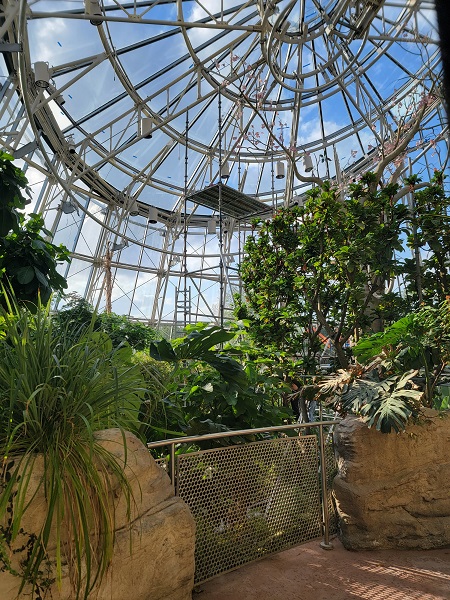Fall is coming! Leaves are changing color, temperatures start creeping down, and gardeners will be able to get back outside without the threat of heatstroke.
Well, in theory. This is Houston, after all.
But despite the fact that it’ll be warm until Thanksgiving, there is something we can look forward to: cooler temps! And you know what else likes cooler temps? Plants! Plants can get a little stressed out in the hot, dry summer months, and some will even go into a dormant state (which means they cease to grow to conserve as much energy as they can). This type of dormancy is usually caused by drought stress.
If you’re like me, you don’t like to spend a lot of money irrigating your landscape, so my solution is to choose plants that do not need regular watering. There are many great butterfly nectar and host plants that are drought-tolerant and we will have several of these at the Cockrell Butterfly Center’s Fall Plant Sale. We choose the hardiest perennials and annuals to help you stock up your landscape before the fall butterfly rush.
Here is my top 10 plant list for this fall:
1. Flowery Senna or Yellow Senna (Cassia splendida): This perennial shrub is covered in bright yellow clusters of flowers from fall through winter. It is also the host plant for several sulfur butterfly larvae. Cassia can reach heights of 6 to 12 feet tall, likes full sun, and has average water needs.
2. Fringed Twinevine (Funastrum cynanchoidies): This perennial vine is a great butterfly attractor for the fall. The pale pink flowers look similar to milkweed flowers, since they are in the same family, Apocynaceae. In fact, twinevine (unfortunately) attracts the yellow oleander aphid, just like milkweed! Monarchs will not lay eggs on the plant, but the caterpillars will eat the leaves in desperate times when milkweed is not available. Queen caterpillars will also eat this plant. This unusual plant is native to the southwestern United States, including south Texas. It is a twining vine and will need some sort of trellising.
3. Fall Mistflower or Common Floss Flower (Eupatorium odoratum, or Chromolaena odoratum): When the pale blue flowers of this plant appear, they are swarmed by many species of butterflies. The bushy plant grows 3 to 5 feet high and has low water needs. Plant in full sun for maximum blooms. Note that it only blooms for about 3 weeks, starting mid-to-late October, but the butterfly show is worth the wait.
4. Blazing Star (Liatris sp.): This Texas native perennial is a great nectar plant for summer and early fall. It likes full sun and is drought tolerant. The bloom spikes reach 3 to 4 feet tall. It also attracts hummingbirds!
5. Sassafras (Sassafras albidum): This tree is also a native to Texas. It usually occurs as an understory tree at the edge of wooded areas, so they like a little bit of shade. They can reach up to 30 feet tall and, once their root system is established, they are drought tolerant. This tree has wonderful fall color and is also deciduous, which means that they drop all of their leaves in winter. So, if your Sassafras looks like sticks, don’t worry, it will come back in the spring. Another great thing about this tree (and the reason why we sell it) is that it is a host plant for the Spicebush Swallowtail. The utter cuteness of the Spicebush Swallowtail Caterpillar, in my opinion, makes it a great ambassador for butterfly gardening. It is a favorite of many butterfly enthusiasts.
6. Corell’s Obedient Plant (Physostegia corellii): A Texas native, this perennial likes full to partial shade and needs regular watering. Plant height reaches about 3 feet tall and the pink flower spikes bloom mid to late summer. It is a great nectar plant for butterflies and hummingbirds.
7. Brazilian Pipevine (Aristolochia fimbriata): This trailing groundcover with attractive, slightly variegated, roundish leaves, likes part shade and average watering, but will become drought tolerant when established. The plant is named after its flowers, which resemble small tobacco pipes. These unusual maroon-colored flowers attract flies to pollinate them with their “fragrance” of rotting meat. The flies think this is a good place to lay their eggs, but in reality they are just doing the plant’s bidding! This plant is also the host for the native Pipevine Swallowtail and the more tropical Polydamas Swallowtail. The funky looking caterpillars can devour the foliage all the way to the ground, but luckily the plant is ready for this and will flush out new growth from its fleshy underground storage root. If you want this plant for raising caterpillars you should plant several to have enough food for your babies.
8. Frog Fruit (Lippia nodiflora): This native groundcover likes full sun to partial shade and blooms spring through early winter. It is a good nectar plant for small butterflies like hairstreaks and skippers. The leaves are also a host for buckeye larvae. If you have a large open space that needs some groundcover, this is the plant for you! Otherwise, you may want to contain its vigorous growth.
9. Mexican Caesalpinnia (Caesalpinnia mexicana): This woody perennial reaches 7 to 8 feet high, and produces large clusters of yellow flowers from early summer through early winter. A great nectar plant for butterflies, it likes full sun and is drought tolerant.
10. Red Rocket Russelia (Russelia sarmentosa): This tender perennial is a great nectar plant for butterflies and hummingbirds. It likes full sun to part shade and is drought tolerant, and bears “fiery” red spikes of flowers that bloom from summer to fall.. For some reason it is not found in garden centers lately, but we have it!
The Semi-Annual Plant Sale will be held Saturday, October 12 from 9:00 a.m. to noon, or until we sell out of plants. Come early, because the plants go fast!












